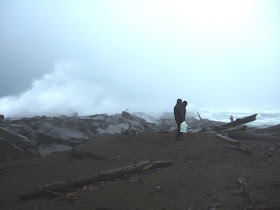I live less than a mile from a salt water bay. However, I really do not feel like I live near the ocean. A trip to the ocean beaches versus the inland waters beaches of Washington is a fairly long drive. I refer to the ocean beach and shores of the western edge of Washington State as the "Outer Coast".
The southwest outer coast is made up of huge sand beaches with large drowned estuaries of the Columbia River, Willapa Bay and Grays Harbor. The sandy shallows extend far off shore and hence the initial breakers are a couple of thousand feet off the beach.
Surf from near Ocean Shores
It was hard to judge how big the initial waves were. The National Weather Service had predicted 20 to 25 foot swells off the coast down from 25 to 30 two days before. The NWS also issued this warning:
A HIGH SURF ADVISORY MEANS THAT HIGH SURF WILL AFFECT BEACHES IN THE ADVISORY AREA...PRODUCING LOCALIZED BEACH EROSION AND DANGEROUS SWIMMING CONDITIONS.
No desire to swim, but we did venture out in the stormy weather to Point Brown near the end of the long Ocean Shores peninsula.
Beach combers looking for storm treasures
The rain hurts when the wind is blowing 50 mph. There was a 2-foot storm surge added onto the already high tide. I noted the pair of folks above were pros - they wore goggles. A brilliant idea with the high wind and rain and flying salt spray. One other note - I took a look at the large jetty rocks and they sure look like they came from greenschist quarries in Skagit County. Big massive blocks that can take large waves.
Around the tip of the peninsula we checked out the recent and ongoing erosion.
End of the old road to Protection Island
20 years ago all the water area in this picture was land
Shoreline barrier peninsulas are dynamic places. The southwest Washington State coast is a land of barrier peninsulas and like similar landforms on the Atlantic coast and Gulf coast of the United States this is a place of changes that can readily be seen within individual life spans.
A look at Google earth for a quick sense of the change captures the change since 1990. Protection Island (currently and in both images a continuation of the spit) is on the right in the image below. Point Brown is on the left.
1990
2013
Natural change, dredging to keep the harbor open, jetties and marinas all can trigger changes in the shoreline processes and where sediment gets eroded and deposited. Compared to the Atlantic coast and Gulf coast our beaches might be a bit more dynamic due to the greater frequency of large storms with high wind and the very large waves the Pacific Ocean routinely sends up against our outer coast. We also have a bit of a tectonic issue that adds an additional and very significant dynamic to the shoreline processes. (I will note I had my tsunami escape routes in mind at all times)
A closer look at the erosion site shown above over time:
1990 (note the road)
2006
2011 (note the road ending in the water)









No comments:
Post a Comment